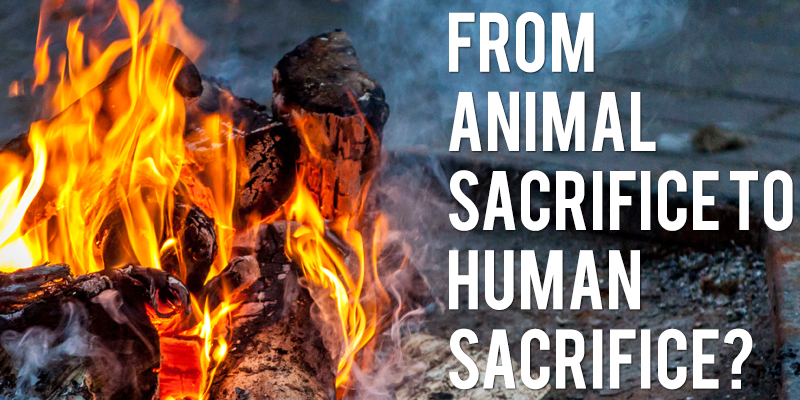
ANIMAL SACRIFICE TO HUMAN SACRIFICE?
The author of the Book of Genesis, with the help of the religious experience of Abraham, instructs the people of Israel against the practice of human sacrifices of the primitive religious traditions. Experts have identified sixteen texts from the Old Testament which directly or indirectly has a reference to the human sacrifice. (2 Kings, 3, 27; 17, 31; Deuteronomy 12, 31; Judges 11, 30-39; Leviticus 18, 21; 20, 2-6; Exodus 13, 12-15; Jeremiah 7, 31; 19, 5; Ezekiel 23, 37-39, etc.) Since the people of Israel was always on the move in search of pastures for their herds, they encountered other human communities and their religious practices. Whenever the basic motifs of the religion were challenged by some religious practices, the scripture writers spoke in the name of God to help the people arrive at a better religious consciousness and consequent practices. Thus the author encourages the people to perform the rite of animal sacrifices to please God instead of human sacrifices.
But the New Testament writers, preaching on the life and teachings of Jesus proposes again human sacrifice to please God! We read in the Letter to the Hebrews: “…. it is impossible for the blood of bulls and goats to take away sins. Consequently, when Christ came into the world, he said, “Sacrifices and offerings thou hast not desired, but a body hast thou prepared for me; in burnt offerings and sin offerings thou hast taken no pleasure. Then I said, ‘Lo, I have come to do thy will, O God,’ … He abolishes the first in order to establish the second. And by that will we have been sanctified through the offering of the body of Jesus Christ once for all.” (Heb 10, 4-10) How can we understand this new proposal of human sacrifice? Is it a going back into our old underdeveloped religious consciousness? In what way sacrifice of the body and blood of Jesus is different from the human sacrifice of the primitive regions?
Jesus lived thirty years of his life in the Jewish religious tradition, strictly observing its laws and the regulations. He was obedient to his parents, he grew in wisdom and stature, and he lived a life in favor with God and man. At the age of thirty Jesus is guided by the Spirit of God to the desert. Jesus makes a pilgrimage of faith for forty days and forty nights with a new vision of God, world and man. He is encompassed with some practical questions that confronted his religiosity and he has to come out with an updated and integral religiosity. In the Gospel of Mark we see how Jesus realized his vision within himself in his each spiritual exercise. (Mark 9, 2-10) He took with him his three intimate disciples so that they may witness his transfiguration which occurred each time he united himself with his Heavenly Father in prayer. He was so totally united to his Father that he became the true and real presence of God on earth. He showed the disciples how heaven and earth will be harmoniously united around the human being in a true prayer. A harmonious comprehension of God, world and man, which is the fruit of prayer, enabled Jesus to accept even the unjust death on a cross for the good of all people. The words of Paul also help us to contemplate how God loved us so much and continue to love us, sacrificing himself through his only son Jesus Christ. He explains how the realization of God’s immense love for the humanity overshadows the man of prayer with a heroic self confidence and courage. (Rom 8, 32-35)
It is the actualization of this new vision of humanity which Jesus enjoyed within himself that we proclaim as New Testament. In the primitive religion the human sacrifice was performed out of fear and compulsion to please a god of favors and punishments. The sacrifice of the self in the
New Testament is performed out of love and freedom by a person who contemplates the merciful God whom Jesus called ‘papa’. While the human sacrifice of the old religious tradition is brutal termination of a life, that of the New Testament is a living of a person like Jesus in humility, patience and mercy. While the previous disfigures the humanity and begets fear and anxiety, the second transfigures the humanity and generates peace and hope. Although the life continues in the self sacrifice of the New Testament, there is also a discontinuity of the life of selfishness and pride and therefore it is a sacrifice.
Only when we are transfigured with Jesus on the mountain of prayer imbibing into us the religious consciousness of Jesus, we will have courage and strength to overcome the forces of the world that disfigure the image of God in us. Let us illumine our daily life by entering into the world of God where we are connected with all the living beings through the Spirit of God who overshadows the entire universe. Then, like Jesus we will be able to go to the people with God in our hearts.
Share on Facebook Share on Twitter Share on Pinterest